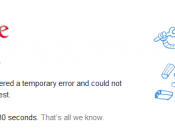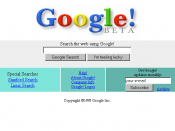I. Industry Analysis
Competition
The web search industry is characterized primarily by an oligopolistic competition within Google, Yahoo, Microsoft, and AOL. The Big 4 serve the entire market and share similar basic infrastructures and activities. So they compete in such segments as market share, technology and methods used, revenue, and share price.
High barriers to entry. Consolidated market with the high amount of R&D required.
Competition mainly on market share (differentiated product)
Google's website, Google.com had a 37% share of all U.S. searches in Q3 2005, Yahoo.com, its closest rival, had a 30% share.
Leveraging its own traffic and that of AOL, Ask.com, and other affiliates, Google garnered about 60% of U.S. search-related advertising revenue in 2005.
Outside the United States, Google.com held a commanding 68% share of all search traffic in Q3 2005.
In June 2000, one year after it was founded, Google's index of 1 billion web pages surpassed those of its rivals.
In 2000, Google replaced Inktomi as Yahoo's search engine.
Microsoft was threatened by Google's ad-supported software.
In 2005, Microsoft responded to Google's ad-supported software threat by proposing a joint venture with AOL to develop search related advertising.
High customer loyalty
See Exhibit x for detailed competition profile among the big players
Products
Google's range of products fueled speculation about Google's strategic objectives.
Google had launched a flurry of products that had expanded its domain beyond web search including Gmail, Google Desktop, Google Maps, Google Book Search, and Google Talk.
Products like Talk and Gmail, along with personalization features offered on Google's home page, moved the company further into the domain of portals like Yahoo! And Microsoft's MSN.
Base, Book Search, and Maps along with a payment service acknowledged to be under development, suggested that Google could be targeting e-commerce giants like eBay and Amazon.
Google's ad-supported software and rumored web-based products such as calander program and an "open office" suite threatened Microsoft.
See exhibit 3 for a list of Google services and products.
Search Technology
The PageRank search algorithm used by Google is the most advantageous and of the highest quality search method ever used for web search.
Before 198, web site developers exploited search algorithms by repeating keywords on their pages, as a result searches increasingly returned irrelevant listings called "spam".
Google ignored the two dominant web search technologies of the time: AltaVista and Inktomi
In 1998, Google cofounders, Sergey Brin and Larry Page, came up with PageRank algorithm, which delivered more relevant searches.
The PageRank algorithm was required to solve an equation with 500 million variables and 3 billion terms.
Market Share
Google has the highest U.S. and International search query share.
A survey on search engine attributes valued by users, over 50% of respondents chose Google as their preferred search engine (see exhibit 8).
In 2005 Google garnered about 60% of U.S. search-related advertising revenue.
In 2005, outside the United States, Google.com held a commanding 68% share of all search traffic in Q3 2005.
Yahoo held the second highest U.S. and international market share (see Exhibit 2)
Revenue
Thanks to "click-through" method and paid listing, Google's revenue became maximized.
Until December 1999, Google earned revenue strictly by licensing its search technology to Yahoo and other sites and its website carried no advertising.
In December 1999, Google's paid listings were priced on a cost-per-impression basis, which charged marketers a fixed price each time their ad was viewed.
Ordering paid listing to "cost-per-impression" auctions yielded results that met users' needs.
In 2003, Google earned gross revenues-derived almost entirely from paid listing- of $1.5 billion.
Google's revenue grew incredibly through years 1999-2005 (see Exhibit 1).
Revenue generating strategy ( Business Model)
Google's reveneue not only came from "coverage rate", "click-through rate", "average cost per click", and "revenue split"; But also from " contextual paid listing" and other new search domains such as "Froogle".
Exploiting "click-through" method maximized Google's revenue.
Leads that were generated by a search engine were more effective for marketers than banner ads on other websites because search engine users often were researching products and services that they planned to purchase soon.
70% of all e-commerce transactions originated through web search.
40% of all web searches had a commercial motivation.
Spending on paid listings grew rapidly (see Exhibit 4).
In 2002, Google launched Froogle, a product search service that identified merchants for specific products, along with their prices
In 2003, Google expanded beyond search-related advertising by launching "contextual" paid listings.
Culture
Google will take opportunities that might sacrifice short-term results but are in the best long-term interest of its shareholders and will encourage innovation.
The company encouraged engineers to devote 20% of their time to work on independent projects; Innovations such as Google News, AdSense, and Gmail had emerged from these independent projects.
No one can buy better PageRank and get higher in search results; users trust Google's objectivity and no short-term gain could ever justify breaching that trust.
All Google's new product ideas emerged bottom-up from the employee ranks, rather than top-down from centralized planning processes.
Google adapted unconventional approaches for managing innovation, which initially seemed risky.
To encourage rapid execution and increase productivity, Google engineers typically worked in teams of only three to five people.
Governance Structure
Dual-class equity structure, which will dilute investors' influence over the company's direction and will allow Google to concentrate on its core, long-term interest, despite fluctuations in quarterly results.
Dual-class equity structure gives ten votes per share to holders of Class B stock, versus on vote per Class A share.
The top management trio would own, in aggregate, roughly one-third of Google's shares but would control over 80% of shareholder votes.
In response to reservation's from investors about Google's unusual reliance on a top management trio, Page-cofounder- acknowledged that to facilitate timely decisions, the top management meet daily, decisions are often made by one of them with others being briefed later, and for important decisions they discuss the issue with the larger team.
II. Competitor Analysis
III. Analysis of the Focal Firm
IV. Analysis of the Focal Firm in its Environment
Cause Map
�
VI. Problem Definition
VII. Strategy
VIII. Strategy Evaluation
IX. Appendices
Exhibit 1 Google Financials, 1999-2005 ($ in millions)
1999 | 2000 | 2001 | 2002 | 2003 | 2004 | 2005 | |
Revenue: | $0.20 | $19.10 | $86.40 | $439.50 | $1,465.90 | $3,189.20 | $6,138.60 |
- ad revenue | |||||||
*Google sites | N/A | N/A | 66 | 307 | 792.1 | 1589 | 3377 |
*Network sites | N/A | N/A | _ | 103.9 | 628.6 | 1554.3 | 2688 |
- Licensing and other | N/A | N/A | 19.5 | 28.6 | 45.3 | 45.9 | 73.6 |
Traffic acquisition cost (for network sites) | _ | _ | _ | $94.50 | $525.60 | $1,228.70 | $2,115.00 |
Cost of net revenue (for data centers, bandwidth,etc.) | 0.9 | 6.1 | 14.2 | 37 | 99.3 | 229 | 456.5 |
R&D | 2.9 | 10.5 | 16.5 | 31.7 | 91.2 | 225.6 | 484 |
Sales and marketing | 1.7 | 10.4 | 20.1 | 43.8 | 120.3 | 246.3 | 439.7 |
G&A | 1.2 | 4.4 | 12.3 | 24.3 | 56.7 | 139.7 | 335.3 |
Stock-based compensation | _ | 2.5 | 12.4 | 21.6 | 229.4 | 278.7 | 200.7 |
Yahoo patent litigation settlement | _ | _ | _ | _ | _ | 201 | _ |
Contribution to Google Foundation | _ | _ | _ | _ | _ | _ | 90 |
TOTAL EXPENSES | $6.70 | $33.90 | $75.50 | $252.90 | $1,122.50 | $2,549.00 | $4,121.20 |
Income(loss) from operations | ($6.50) | ($14.80) | $10.90 | $186.60 | $343.40 | $640.20 | $2,017.40 |
Net Income | ($6.10) | ($14.70) | $7.00 | $99.70 | $105.60 | $399.10 | $1,465.40 |
Cash and marketable securities, year-end | $20.00 | $19.10 | $33.60 | $146.30 | $334.70 | $2,132.20 | $8,034.30 |
Purchases of property and equipment | N/A | N/A | 13.1 | 37.2 | 176.8 | 319 | 838.2 |
Depreciation and amortization of property and equipment | N/A | N/A | 9.8 | 17.8 | 43.9 | 128.5 | 256.8 |
Acquisitions, net of cash acquired | N/A | N/A | _ | _ | 40 | 22 | 86.5 |
Revenue by Geography | |||||||
- United States | N/A | N/A | $74.00 | $275.30 | $707.90 | $2,127.10 | $3,744.50 |
- International | N/A | N/A | 12.4 | 72.5 | 254 | 1,062.20 | 2,394.00 |
Source: Google S1 and 2005 10K statement
Exhibit 2 U.S. and International Search Engine Market Share
* "Others" include AOL and Ask.com, which had 8.7% and 6.5% shares in November 2005, respectively.
Source: Compiled and adapted from comScore Media Mtrix data, from Mark Mahaney, "GOOG: Increased Conviction in Google, " Citigroup Global Markets, Citigroup, December 8, 2005, http://www.comscore.com/metrix/, via Thomson Research/ Investext, accessed December 12, 2005).
Exhibit 3 Select List of Google's Products and Services
Product/Service(by Year Introduced) | Description |
2000 | |
Non-English search | Google Launched in ten languages; expanded to 120 by 2006 |
Directory | Organized by volunteer editors |
Wireless search | Google accessible on wireless devices |
AdWords | Keyword-targeted advertising with pay-per-impression model |
Toolbar | browser plog-in |
2001 | |
Deja.com(acquisition) | search archive of Usenet postings and message threads |
Image Search | Launched with 250 million images; over 1 billion by 2006 |
Zeitgeist | Real-time statistics on popular queries |
Catalog Search | Search and browse over 1,100 mail-order catalogs |
2002 | |
Search Appliance | Plug-and-play enterprise search solutions |
Web APIs | Release of Google's first application protocol interface, allowing Third party programs to query Google directly |
AdWords | Pay-per-click model added |
Compute | took advantage of idle cycles on users' PCs to help solve computationally-intensive scientific problems |
News | Launched with access to 4500 news sources from around the world |
Froogle | Product search services |
2003 | |
Pyra Labs(acquisition) | Offered Blogger.com's blogging tools and hosted services |
AdSense | Contextual ads |
Deskbar | Put search box in the Windows task bar |
Local Search | Search within local geographies |
2004 | |
SMS | Search through cell phone text messaging |
Keyhole(acqusition) | Satellite image mapping; relaunched as Earth in 2005 |
Picasa | Digital photo management |
Orkut | Social networking |
Zipdash(acquisition) | Real-time traffic information |
Hello | Post photos to blogs and share via instant messaging |
Gmail | E-mail service |
Personalized Search | Search results reflect user's past behavior; incorporates Search History |
Desktop search | Search contents of a user's PC files |
Book Search | originally called Google print; searches contents of books provided by publishers and several libraries |
2005 | |
Personalized Home Page | Incorporates RSS feeds, Gmail, search History, etc. |
Talk | Instant messaging and VoIP service |
Dodgeball | Social networking for mobile users |
Sitemaps | webmasters prioritize which pages Google crawls first and alert Google when pages have been updated |
Blog Search | Search blog contents |
Urchin Software (acquisition) | Advertising analytics software allows advertisers to track marketing campaign performance |
Maps | Online mapping for North American users; intgrated with Keyhole satelite images |
Video | Search archive of video programs submitted by rights holders |
webaccelerator | Speed web page delivery |
Source: Google Inc., Harvard Business School, November 9, 2006
Exhibit 4 U.S. Paid-Listings Spending Forecast, 2005-2010 ($millions)
2004 | 2005 | 2006 | 2007 | 2008 | 2009 | 2010 | |
Paid search | $2,974 | $3,949 | $4,873 | $5,682 | $6,444 | $7,113 | $7,740 |
Contextual listings | $648 | $914 | $1,181 | $1,426 | $1,665 | $1,881 | $2,089 |
Paid inclusion | $222 | $271 | $321 | $366 | $408 | $447 | $485 |
Agency fees | $424 | $527 | $691 | $813 | $946 | $1,092 | $1,258 |
Total | $4,268 | $5,661 | $7,066 | $8,287 | $9,463 | $10,533 | $11,572 |
Search ad spending as % of total online ad spending | 36% | 39% | 41% | 42% | 43% | 44% | 44% |
Source: U.S. Online Marketing Forecast: 2005-2010, Forrester Research Trends, (May 2, 2005)
Location
Products Development
R&D
Governance Structure
Licensing
Brand
Search Technology
Culture
Products
Business Model
Innovation
Goal
Cost advantage
Capital Requirements travel
Costs
Profits
Revenues
Market
Share
Suppliers
Competitors
Competition
Barriers
To Entry
Buyers
Demand
�PAGE � �PAGE �1�
_1240863860.xls
Chart1
| 0.34 | 0.3 | 0.16 | 0.2 |
| 0.35 | 0.28 | 0.14 | 0.23 |
| 0.36 | 0.31 | 0.15 | 0.19 |
| 0.35 | 0.33 | 0.16 | 0.16 |
| 0.37 | 0.32 | 0.16 | 0.16 |
| 0.38 | 0.31 | 0.15 | 0.17 |
| 0.39 | 0.3 | 0.16 | 0.16 |
Sheet1
| Yahoo | MSN | Others | ||
| Q1:04 | 34% | 30% | 16% | 20% |
| Q2:04 | 35% | 28% | 14% | 23% |
| Q3:04 | 36% | 31% | 15% | 19% |
| Q4:04 | 35% | 33% | 16% | 16% |
| Q1:05 | 37% | 32% | 16% | 16% |
| Q2:05 | 38% | 31% | 15% | 17% |
| Q3:05 | 39% | 30% | 16% | 16% |
| Yahoo | MSN | Others | ||
| Q1:04 | 52% | 32% | 11% | 6% |
| Q2:04 | 58% | 23% | 8% | 12% |
| Q3:04 | 57% | 25% | 7% | 14% |
| Q4:04 | 58% | 23% | 8% | 12% |
| Q1:05 | 61% | 19% | 10% | 10% |
| Q2:05 | 68% | 18% | 9% | 9% |
| Q3:05 | 69% | 17% | 9% | 9% |
Sheet1
| 0 | 0 | 0 | 0 |
| 0 | 0 | 0 | 0 |
| 0 | 0 | 0 | 0 |
| 0 | 0 | 0 | 0 |
| 0 | 0 | 0 | 0 |
| 0 | 0 | 0 | 0 |
| 0 | 0 | 0 | 0 |
Sheet2
| 0 | 0 | 0 | 0 |
| 0 | 0 | 0 | 0 |
| 0 | 0 | 0 | 0 |
| 0 | 0 | 0 | 0 |
| 0 | 0 | 0 | 0 |
| 0 | 0 | 0 | 0 |
| 0 | 0 | 0 | 0 |
Sheet3
_1240864021.xls
Chart2
| 0.52 | 0.32 | 0.11 | 0.06 |
| 0.58 | 0.23 | 0.08 | 0.12 |
| 0.57 | 0.25 | 0.07 | 0.14 |
| 0.58 | 0.23 | 0.08 | 0.12 |
| 0.61 | 0.19 | 0.1 | 0.1 |
| 0.68 | 0.18 | 0.09 | 0.09 |
| 0.69 | 0.17 | 0.09 | 0.09 |
Sheet1
| Yahoo | MSN | Others | ||
| Q1:04 | 34% | 30% | 16% | 20% |
| Q2:04 | 35% | 28% | 14% | 23% |
| Q3:04 | 36% | 31% | 15% | 19% |
| Q4:04 | 35% | 33% | 16% | 16% |
| Q1:05 | 37% | 32% | 16% | 16% |
| Q2:05 | 38% | 31% | 15% | 17% |
| Q3:05 | 39% | 30% | 16% | 16% |
| Yahoo | MSN | Others | ||
| Q1:04 | 52% | 32% | 11% | 6% |
| Q2:04 | 58% | 23% | 8% | 12% |
| Q3:04 | 57% | 25% | 7% | 14% |
| Q4:04 | 58% | 23% | 8% | 12% |
| Q1:05 | 61% | 19% | 10% | 10% |
| Q2:05 | 68% | 18% | 9% | 9% |
| Q3:05 | 69% | 17% | 9% | 9% |
Sheet1
| 0 | 0 | 0 | 0 |
| 0 | 0 | 0 | 0 |
| 0 | 0 | 0 | 0 |
| 0 | 0 | 0 | 0 |
| 0 | 0 | 0 | 0 |
| 0 | 0 | 0 | 0 |
| 0 | 0 | 0 | 0 |
Sheet2
| 0 | 0 | 0 | 0 |
| 0 | 0 | 0 | 0 |
| 0 | 0 | 0 | 0 |
| 0 | 0 | 0 | 0 |
| 0 | 0 | 0 | 0 |
| 0 | 0 | 0 | 0 |
| 0 | 0 | 0 | 0 |



Great paper
This was a really good paper. It hit everything required, and was extremely thorough. Everything we ever wanted to know about Google was right here.
1 out of 1 people found this comment useful.